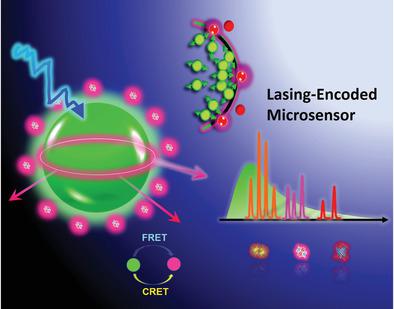当前位置:
X-MOL 学术
›
Adv. Opt. Mater.
›
论文详情
Our official English website, www.x-mol.net, welcomes your
feedback! (Note: you will need to create a separate account there.)
Lasing‐Encoded Microsensor Driven by Interfacial Cavity Resonance Energy Transfer
Advanced Optical Materials ( IF 8.0 ) Pub Date : 2020-01-20 , DOI: 10.1002/adom.201901596 Zhiyi Yuan 1 , Ziyihui Wang 2 , Peng Guan 2 , Xiaoqin Wu 3 , Yu‐Cheng Chen 1, 4
Advanced Optical Materials ( IF 8.0 ) Pub Date : 2020-01-20 , DOI: 10.1002/adom.201901596 Zhiyi Yuan 1 , Ziyihui Wang 2 , Peng Guan 2 , Xiaoqin Wu 3 , Yu‐Cheng Chen 1, 4
Affiliation

|
Microlasers are emerging tools for biomedical applications. In particular, whispering‐gallery‐mode (WGM) microlasers are promising candidates for sensing at the biointerface owing to their high quality‐factor and potential in molecular assays, and intracellular and extracellular detection. However, lasing particles with sensing functionality remain challenging since the overlap between the WGM optical mode and external gain medium is much lower compared to internal gain inside the cavity. To overcome this problem, the concept of Förster resonant energy transfer (FRET) is exploited on WGM droplet microlaser by separating donor and acceptor molecules at the cavity–surface interface. It is first discovered that the interfacial FRET laser not only originates from conventional FRET but utilizes coherent radiative energy transfer (CRET) to excite acceptor molecules by inducing light‐harvesting effect near the cavity interface. Simulations and experiments have revealed that the absorption spectrum of individual analyte plays a crucial role in interfacial FRET laser. Distinct lasing spectra can therefore distinguish molecules of different absorption properties upon binding. Finally, detection of small fluorescent molecules and photosynthetic protein is performed. The results presented here not only demonstrate the wide‐ranging potential of microlaser external cavity implementation in molecular sensing applications, but also provide comprehensive insights into cavity energy transfer in laser physics.
中文翻译:

界面共振能量传输驱动的激光编码微传感器
微激光是用于生物医学应用的新兴工具。尤其是,耳语式图库模式(WGM)微激光由于其高质量因子和分子分析以及细胞内和细胞外检测的潜力,因此有望在生物界面进行传感。但是,具有感测功能的激光粒子仍然具有挑战性,因为WGM光学模式与外部增益介质之间的重叠比腔体内的内部增益低得多。为了克服这个问题,在WGM液滴微激光器上利用Förster共振能量转移(FRET)的概念,即通过分离腔-表面界面处的供体和受体分子。首次发现,界面FRET激光不仅起源于传统的FRET,而且还通过在腔体界面附近引起光聚集效应,利用相干辐射能转移(CRET)来激发受体分子。仿真和实验表明,单个分析物的吸收光谱在界面FRET激光器中起着至关重要的作用。因此,不同的激光光谱可以在结合时区分具有不同吸收特性的分子。最后,进行小荧光分子和光合蛋白的检测。本文介绍的结果不仅证明了微激光外腔在分子传感应用中的广泛应用潜力,而且还为激光物理学中的腔能量传递提供了全面的见解。
更新日期:2020-04-06
中文翻译:

界面共振能量传输驱动的激光编码微传感器
微激光是用于生物医学应用的新兴工具。尤其是,耳语式图库模式(WGM)微激光由于其高质量因子和分子分析以及细胞内和细胞外检测的潜力,因此有望在生物界面进行传感。但是,具有感测功能的激光粒子仍然具有挑战性,因为WGM光学模式与外部增益介质之间的重叠比腔体内的内部增益低得多。为了克服这个问题,在WGM液滴微激光器上利用Förster共振能量转移(FRET)的概念,即通过分离腔-表面界面处的供体和受体分子。首次发现,界面FRET激光不仅起源于传统的FRET,而且还通过在腔体界面附近引起光聚集效应,利用相干辐射能转移(CRET)来激发受体分子。仿真和实验表明,单个分析物的吸收光谱在界面FRET激光器中起着至关重要的作用。因此,不同的激光光谱可以在结合时区分具有不同吸收特性的分子。最后,进行小荧光分子和光合蛋白的检测。本文介绍的结果不仅证明了微激光外腔在分子传感应用中的广泛应用潜力,而且还为激光物理学中的腔能量传递提供了全面的见解。











































 京公网安备 11010802027423号
京公网安备 11010802027423号